Family : Labridae

Text © Giuseppe Mazza

English translation by Mario Beltramini
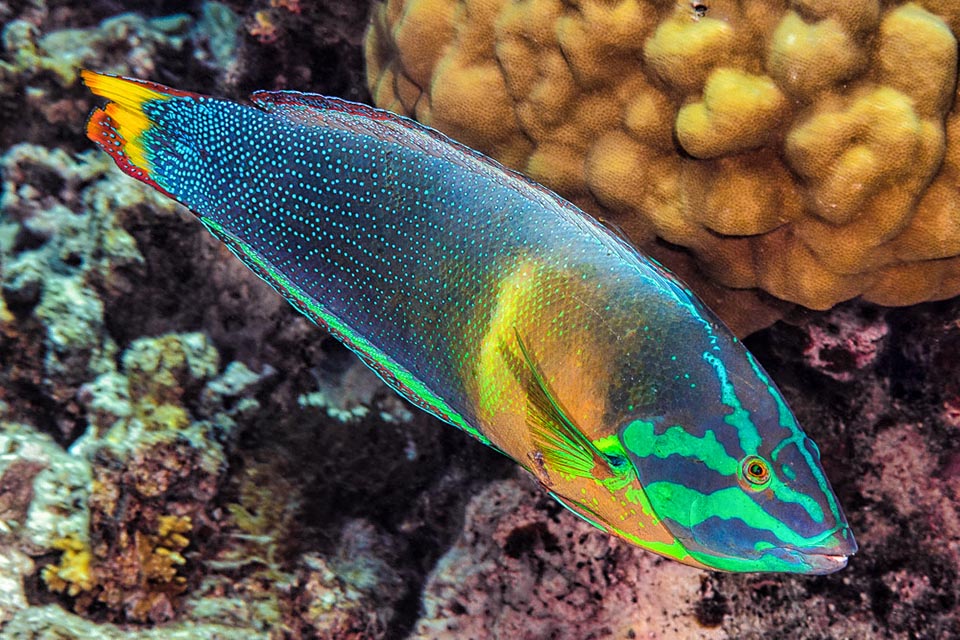
Coris gaimard lives in the tropical waters of the Pacific and nearby Indian oceans, but after some it should reach India and the African coasts © François Libert
The Coris gaimard (Quoy & Gaimard, 1824) belongs to the class of the Actinopterygii, the ray-finned fishes, to the order of the Perciformes and to the numerous family of the Labridae.
The generic name Coris seems to come from the Greek “Κόρη” (kore) that means maid, young girl, due to the elegant look, with thin scales and the bright colours, that well correspond to the images of beauty present in all species of this genus starting from the Mediterranean Coris julis, that, not by a chance, has the vulgar Italian name of Damsel.
The specific term gaimard, honours the memory of the French physician and naturalist Joseph Paul Gaimard (1793-1858).
Zoogeography
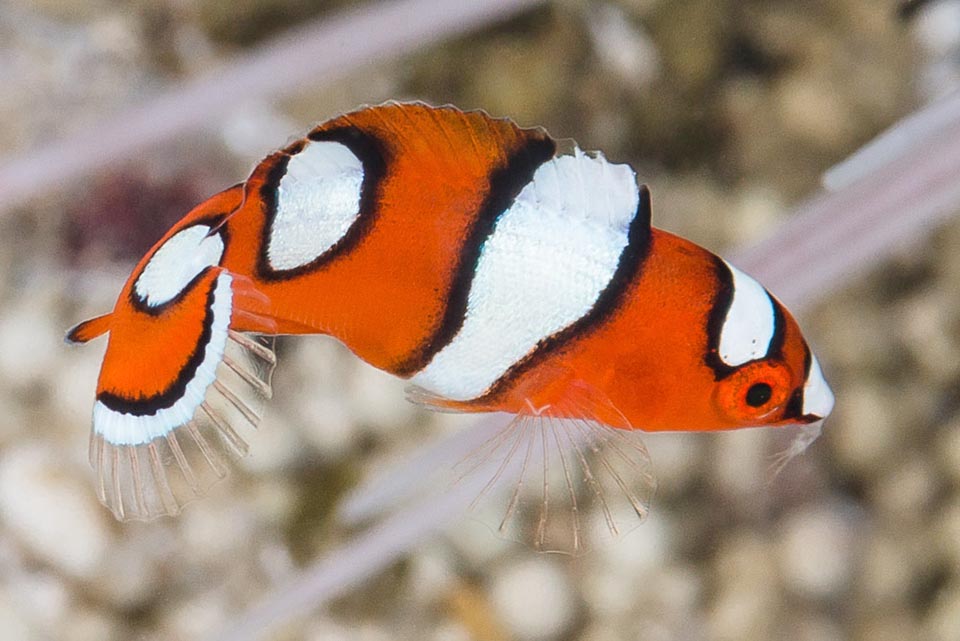
In the early juvenile stage, the flamboyant red livery with mimetic black edged white bands is practically the same as that of the Coris formosa © François Libert
The range of the Coris gaimard has its epicentre in the tropical Pacific Ocean, along the Asian coasts and of Oceania. However, we find it already in the Indian Ocean starting from the Cocos Islands, west to Australia, and reaches then, eastwards, the French Polynesia and the Hawaii. Indicatively, it touches the south of Japan, China, Taiwan, Malaysia, Indonesia, Papua New Guinea, Australia, New Caledonia, Fiji, Samoa and Cook Islands.
Ecology-Habitat
It loves the flat bottoms with fragments of old madreporic formations, places rich of hideouts for its usual preys it looks for between 1 and 50 m of depth, but also those with sand or gravel where the juveniles disappear silting at the first sign of danger.
Morphophysiology
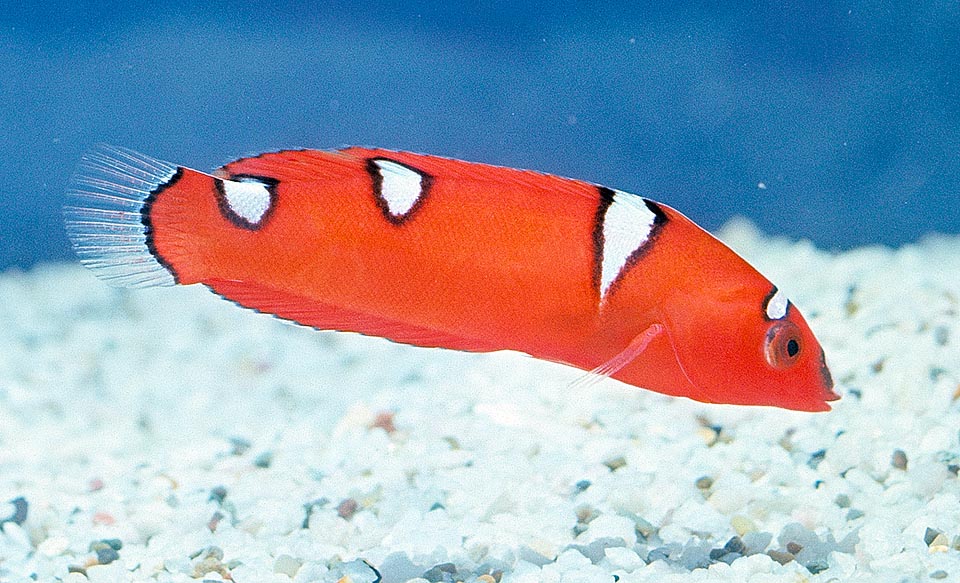
Then the white mimetic bands shrink until they disappear completely © Giuseppe Mazza
Even if the current size is of about 20 cm, the adult males of the Coris gaimard can reach the length of 40 cm after incredible morphological and livery transformations. It is in fact a proterogynous hermaphrodite species, that is with females that while growing transform in males and it is therefore obvious that, seen the age, these are bigger than the partners. However, it does not happen like in other species of Labridae, where are diandrous males, that is as such from the birth, even if camouflaged by a female livery. At the beginning, then, the Coris gaimard are all females. During the first times the juvenile livery is quite similar to that of the Coris formosa: very slender bodies, orange red with 5 spots bordered in black arranged like a saddle on the back. Then, growing, the yellow tail appears, which differentiates, at first sight, all the phases of this species.
The body is tall, very compressed on the sides, with the roundish head in the young females and more pointed in the males, almost double tall. The dorsal fin has 9 spiny rays, with the first particularly long, and 12-13 soft rays; the anal fin 3 spiny rays and 12 soft; the pectoral fins, transparent, 13 soft rays, whilst the pelvic ones are elongated with the first ray spiny.
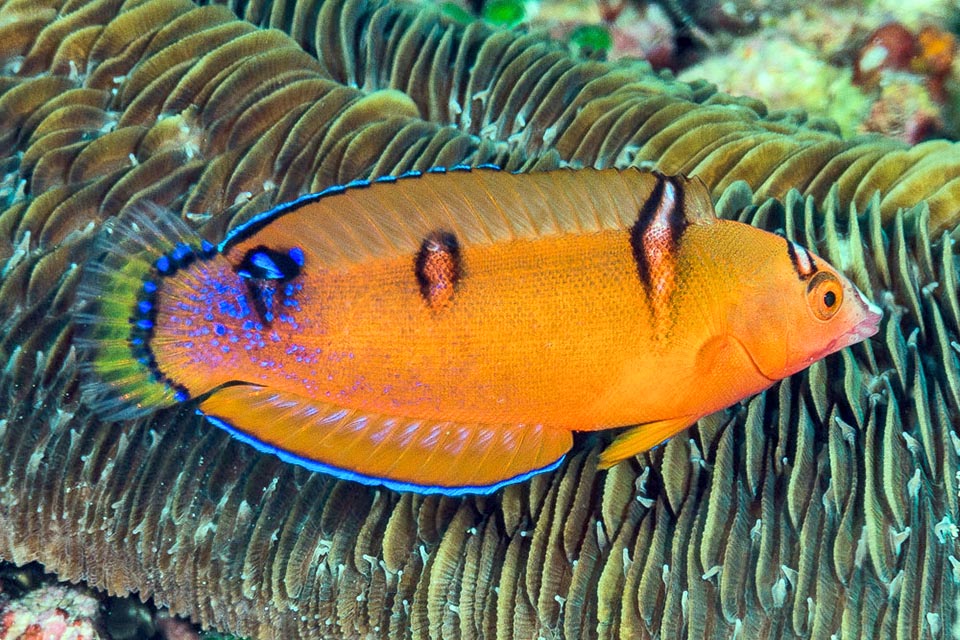
The yellow tail typical to the species appears little by little and makes its way the light blue on the edge of the fins and with an elegant dotting © François Libert
The females are sexually mature starting from the 10 cm of length. The background colour of their livery fades from orange yellow of the head to the dark blue of the tail. Close to the eye we note showy turquoise bands, more visible on the operculum but interesting also the chinstrap. The sides present an elegant blue dotting that gets thicker and intense towards the tail. The dorsal fin and the anal are red with blue margin, colours we find also on the pelvic ones.
The male livery shows a considerable sexual dimorphism. Without prejudice to punctuation, the background colour fades towards the tail from the green to the blue and the belts on the operculum are wider and emerald. At times these drawings and the punctuations are less evident and the hues flatten under a dark purple veil, but apart dimensions and the height of the body, there are no misunderstandings because is always present a characteristic yellowish vertical belt, more or less wide, that seems to cut the fish in two parts. The first caudal is also for the males of a nice bright yellow, constant characteristic of the species rightly vulgarly called “Yellowtail coris” in various English speaking countries.
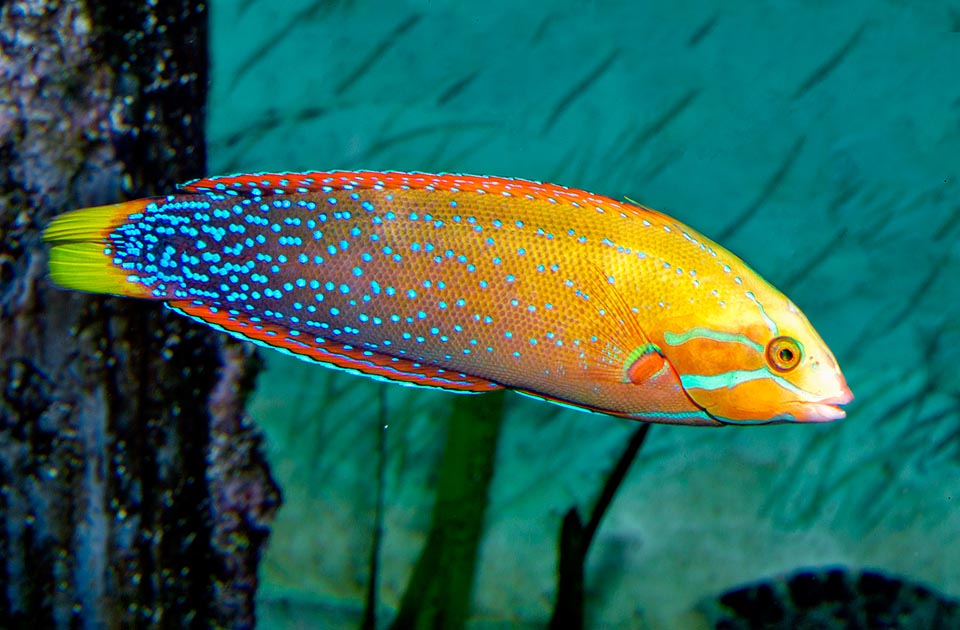
When they reach 10-25 cm the subadults have become all females, a mandatory step before transforming in males © Giuseppe Mazza
Ethology-Reproductive Biology
The juvenile phases nourish of zooplankton, tiny crustaceans and amphipods, but when the solid incisors get out, the Coris gaimard can easily break the armours of crabs, gastropods and bivalves, their diet gets more substantial. They have been even filmed on a bottom while raising with their teeth and turning upside down voluminous madreporic fragments to swallow small sea urchins that were thinking to be safe on the hidden side.
It is a diurnal species. The dominant males control a group of females and when the one in charge is ready to spawn they go up together towards the surface for the mating.
The eggs produced during the nuptial swim, with the female placed under the male, are abandoned to the currents and the larval status lasts about 45 days.
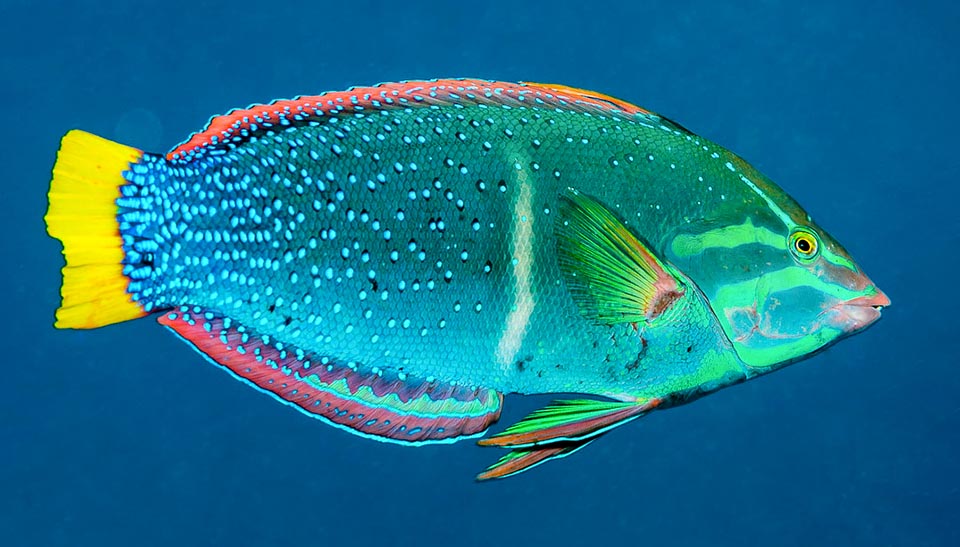
These, even 40 cm long, are actually large-sized females who have changed their sex for reproductive needs, because the alpha male of the group has passed away © François Libert
The young, like those of Coris formosa, well adapt to the life in aquarium and are frequent hosts in the wide pools of the public aquaria, but due to their frantic digging activity and the dimensions of the adult badly befit to the domestic walls.
In addition to the traps for furnishing the aquaria it is a fish that often gets into the nests, consumed locally with the risk of a serious food poisoning, called ciguatera, caused by the presence of poisonous organisms in their diet. In any case it is not an endangered species, because its resilience is good, with a possible doubling in 1.4-4.4 years of the populations, and a still moderate fishing vulnerability index, marking 30 on a scale of 100.
Synonyms
Julis gaimard Quoy & Gaimard, 1824; Coris gaimard gaimard (Quoy & Gaimard, 1824); Julis greenovii Bennett, 1828; Coris greenovii (Bennett, 1828); Julis ganymede Bennett, 1830; Julis leucorhynchos Bleeker, 1856; Coris pulcherrima Günther, 1862; Julis gaimard speciosa Fowler, 1946; Coris gaimard speciosa (Fowler, 1946).
→ For general information about FISH please click here.
→ For general information about BONY FISH please click here
→ For general information about CARTILAGINOUS FISH please click here.
→ To appreciate the BIODIVERSITY of BONY FISH please click here.
→ To appreciate the BIODIVERSITY of CARTILAGINOUS FISH please click here.
